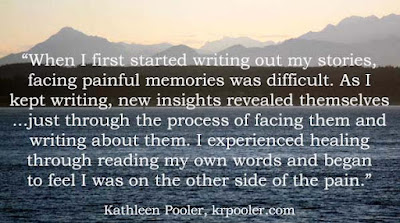Not all memoirs involve deeply sad experiences. Some
are humorous, many are tender. Some are full of adventure.
Others, though, include traumatic incidents.
And so, today, we’ll look at writing a memoir that
includes seared, charred, blistering parts.
I’ve seen something happen too often and saw it
again when my friend began composing his memoir by writing about the most disturbing
year of his life. Wow!
When memoirists start by writing the super-painful
stuff, too often they become overwhelmed all over again with the devastation
they endured—and soon they give up altogether.
Don’t let that happen to you.
A word of caution:
Re-living and writing about past traumas
can cause PTSD.
Consider seeing a good therapist (not all are good!)
before and during your writing.
Begin by composing your easy segments—not the
harrowing ones. Write the funny incidents, the fascinating experiences, the happy
vignettes. That way you can ease your way into both writing and doing the
reflecting that memoir entails.
Jot down thoughts, reactions, questions, memories,
conversations. Create descriptions of key people (click on “No cardboard characters!”)
and of main places in your story (click on “The importance of 'place' in your
memoir”). Before long, you’ll be assembling a rough draft of your memoir.
You don’t have to craft your chapters/vignettes
in the same order they’ll appear
in your completed memoir.
Write them in any order that’s easiest for you.
Later you can organize them in the best way.
My heart wants you to fall in love with:
- pondering,
- and discovering the good stuff you overlooked in the past,
- and making sense of what used to mystify you,
- and discovering how far you’ve come,
- and choosing just the right words,
- and fashioning your memoir as a gift for yourself and for others.
For now, give yourself permission to begin with uncomplicated
parts of your stories. Tackle the hard ones later.
And here’s something interesting: Even if you’re not
physically putting your aching, tender, throbbing accounts into words (with pen
and ink or on a computer screen), you are working on the story. I can’t explain
how that works but, behind the scenes, your heart and brain are working on how
to write the troubling stuff.
Be encouraged by what memoirist Kathleen Pooler said
about writing her two memoirs:
“When I first started writing out my stories, facing
painful memories was difficult. As I kept writing, new insights revealed
themselves to me . . . just through the process of facing them and writing
about them. I experienced healing through reading my own words and began to
feel I was on the other side of pain.” (Kathleen
Pooler, author of Ever Faithful to His Lead and Just the Way He Walked)
If you’re not ready to write, let your heart and
mind rest for a few weeks or months—or however long it takes. Pour out your
heart to God. Wait patiently before Him, putting your hope in Him (Psalm
62:5-6).
He bends down and listens to you. He hears and
answers (Psalm 116:1-2).
Stay alert. One day you’ll be vacuuming the car, or
playing catch with your grandson, or folding laundry, and you’ll have one of those
A-ha! moments.
Or maybe you’ll hear a song, or someone else’s
story, or a Bible verse, or a poem and, out of the blue, God speaks, or maybe
nudges, offering you insight and clarity about your hurtful experiences.
When that happens, listen. Jot down notes to
yourself. You’ll be mining treasures. Later you can use your notes to add to
your rough draft.
Speaking of your rough draft:
It is for your eyes only.
Because of that, you can write it all—the seared,
charred, blistered parts, the questions you never had the courage to ask aloud,
the doubts you kept secret, the anger you kept bottled up.
You will revise your memoir
numerous times before you publish it
so keep this in mind:
You can always delete, or revise,
the bleeding, raw portions of your first draft.
For now, just wrestle them into writing, for your
own sake. (Review last week’s post about using method writing, a creative,
helpful way to recall situations, and then to write about them.)
Invite God to sit close beside you. He wants to help
you remember, maybe to see things differently, to notice the ways He helped in
the past and continues to help you day by day, year by year. He wants you to
see there’s a good place for you on this side of your pain.
My heart longs for you to experience that “He
heals the brokenhearted and binds up
their wounds.” (Psalm 147:3)

No comments:
Post a Comment